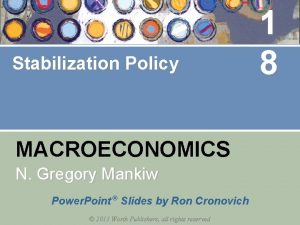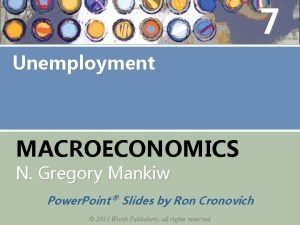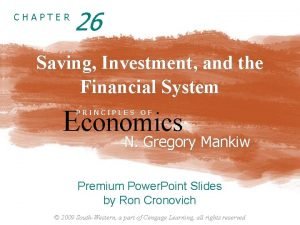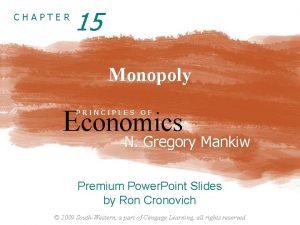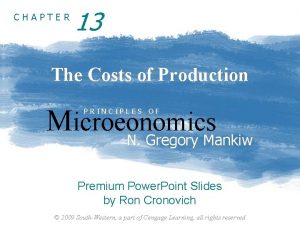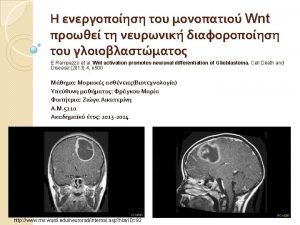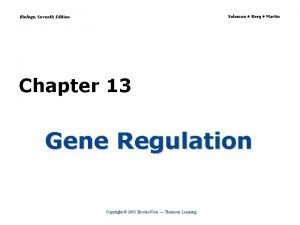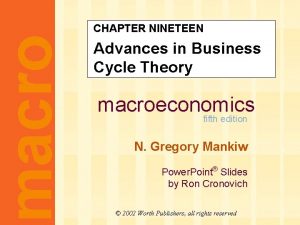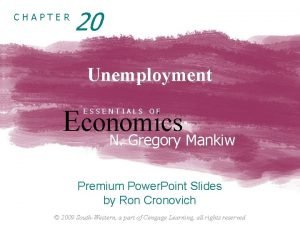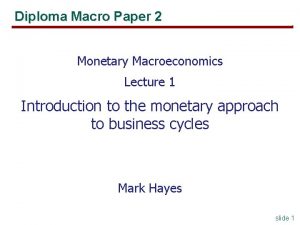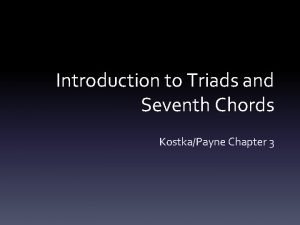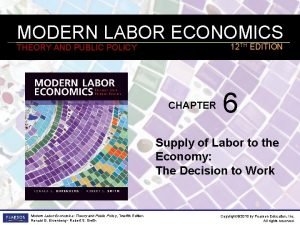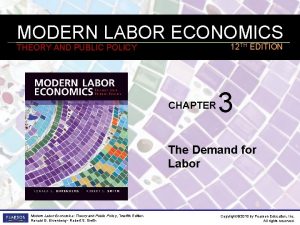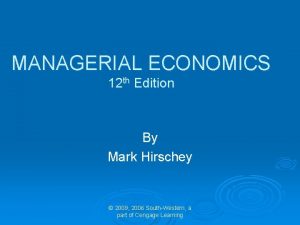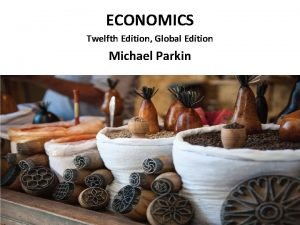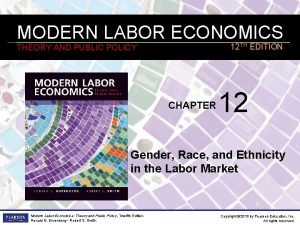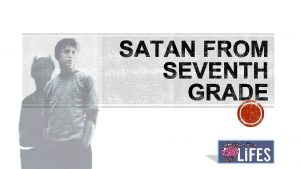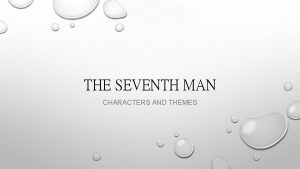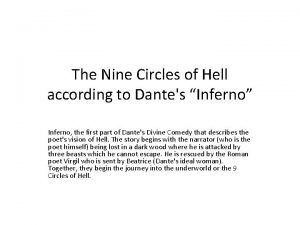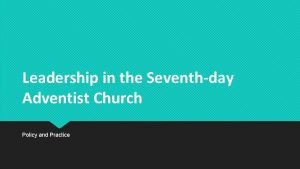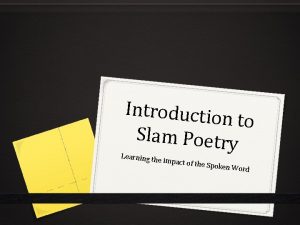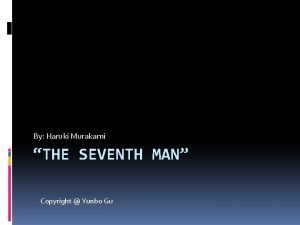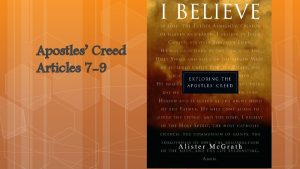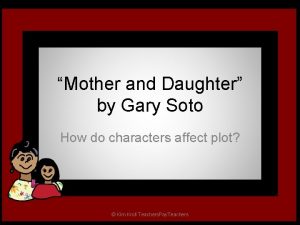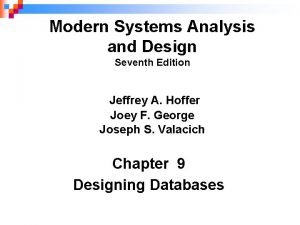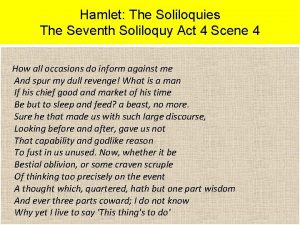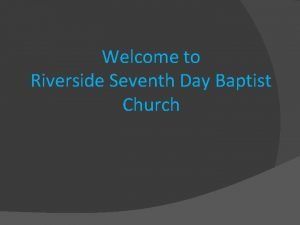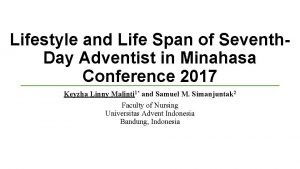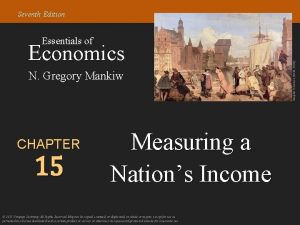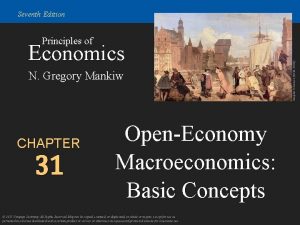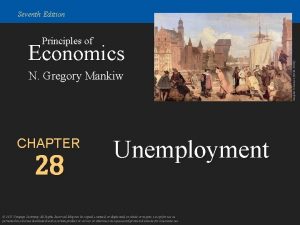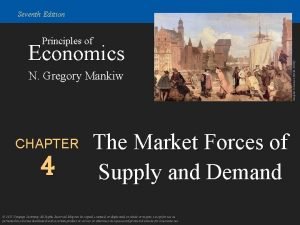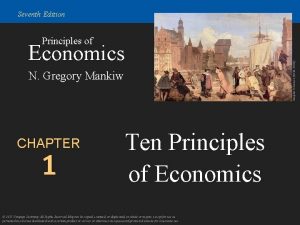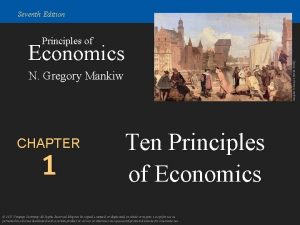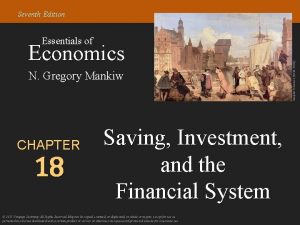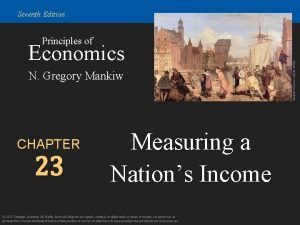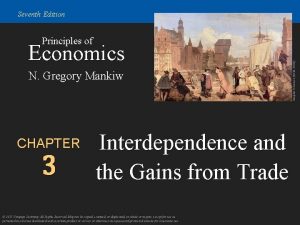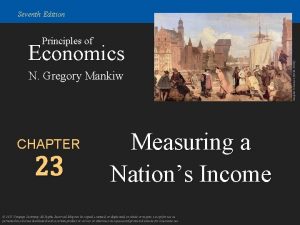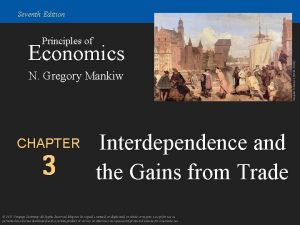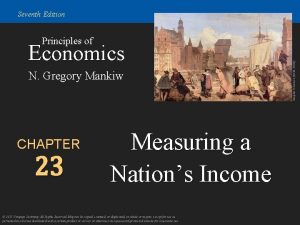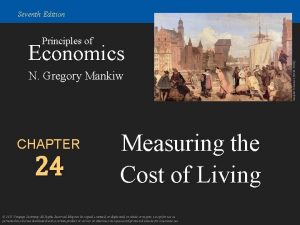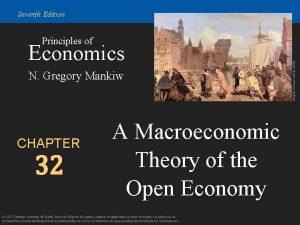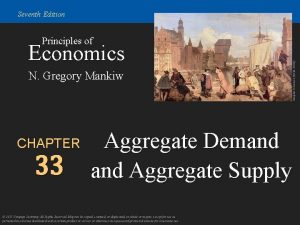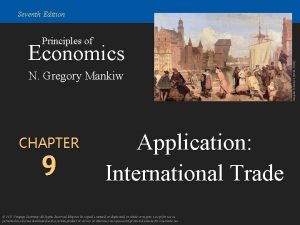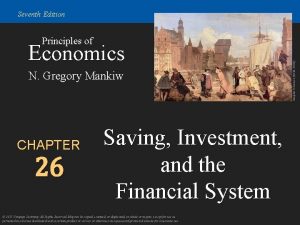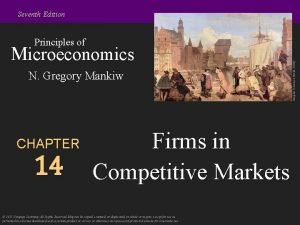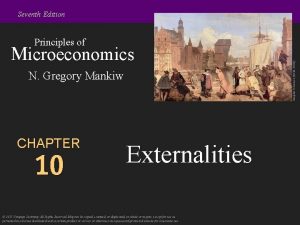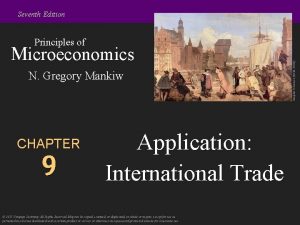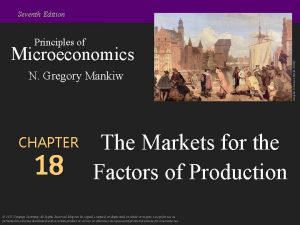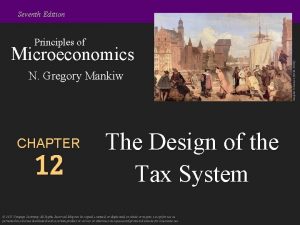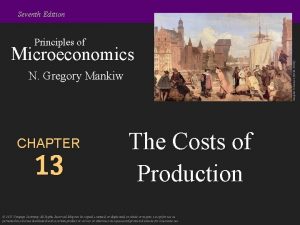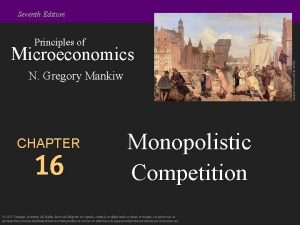Seventh Edition Economics N Gregory Mankiw CHAPTER 29









































- Slides: 41

Seventh Edition Economics N. Gregory Mankiw CHAPTER 29 The Monetary System © 2015 Cengage Learning. All Rights Reserved. May not be copied, scanned, or duplicated, in whole or in part, except for use as permitted in a license distributed with a certain product or service or otherwise on a password-protected website for classroom use. Wojciech Gerson (1831 -1901) Principles of

In this chapter, look for the answers to these questions • What assets are considered “money”? What are the functions of money? The types of money? • What is the Federal Reserve? • What role do banks play in the monetary system? How do banks “create money”? • How does the Federal Reserve control the money supply? © 2015 Cengage Learning. All Rights Reserved. May not be copied, scanned, or duplicated, in whole or in part, except for use as permitted in a license distributed with a certain product or service or otherwise on a password-protected website for classroom use.

What Money Is and Why It’s Important § Without money, trade would require barter, the exchange of one good or service for another. § Every transaction would require a double coincidence of wants—the unlikely occurrence that two people each have a good the other wants. § Most people would have to spend time searching for others to trade with—a huge waste of resources. § This searching is unnecessary with money, the set of assets that people regularly use to buy g&s from other people. © 2015 Cengage Learning. All Rights Reserved. May not be copied, scanned, or duplicated, in whole or in part, except for use as permitted in a license distributed with a certain product or service or otherwise on a password-protected website for classroom use.

The 3 Functions of Money § Medium of exchange: an item buyers give to sellers when they want to purchase g&s § Unit of account: the yardstick people use to post prices and record debts § Store of value: an item people can use to transfer purchasing power from the present to the future © 2015 Cengage Learning. All Rights Reserved. May not be copied, scanned, or duplicated, in whole or in part, except for use as permitted in a license distributed with a certain product or service or otherwise on a password-protected website for classroom use.

The 2 Kinds of Money Commodity money: takes the form of a commodity with intrinsic value Examples: gold coins, cigarettes in POW camps ©kao/Shutterstock. com Fiat money: money without intrinsic value, used as money because of govt decree © Studio Flash/Shutterstock. com Example: the U. S. dollar © 2015 Cengage Learning. All Rights Reserved. May not be copied, scanned, or duplicated, in whole or in part, except for use as permitted in a license distributed with a certain product or service or otherwise on a password-protected website for classroom use. 4

The Money Supply § The money supply (or money stock): the quantity of money available in the economy § What assets should be considered part of the money supply? Two candidates: § Currency: the paper bills and coins in the hands of the (non-bank) public § Demand deposits: balances in bank accounts that depositors can access on demand by writing a check © 2015 Cengage Learning. All Rights Reserved. May not be copied, scanned, or duplicated, in whole or in part, except for use as permitted in a license distributed with a certain product or service or otherwise on a password-protected website for classroom use.

Measures of the U. S. Money Supply § M 1: currency, demand deposits, traveler’s checks, and other checkable deposits. M 1 = $2. 6 trillion (September 2013) § M 2: everything in M 1 plus savings deposits, small time deposits, money market mutual funds, and a few minor categories. M 2 = $10. 8 trillion (September 2013) The distinction between M 1 and M 2 will often not matter when we talk about “the money supply” in this course. © 2015 Cengage Learning. All Rights Reserved. May not be copied, scanned, or duplicated, in whole or in part, except for use as permitted in a license distributed with a certain product or service or otherwise on a password-protected website for classroom use. 6

Central Banks & Monetary Policy § Central bank: an institution that oversees the banking system and regulates the money supply § Monetary policy: the setting of the money supply by policymakers in the central bank § Federal Reserve (Fed): the central bank of the U. S. © 2015 Cengage Learning. All Rights Reserved. May not be copied, scanned, or duplicated, in whole or in part, except for use as permitted in a license distributed with a certain product or service or otherwise on a password-protected website for classroom use.

The Structure of the Fed The Federal Reserve System consists of: § Board of Governors (7 members), located in Washington, DC § 12 regional Fed banks, located around the U. S. § Federal Open Market Committee (FOMC), includes the Bd of Govs and presidents of some of the regional Fed banks. The FOMC decides monetary policy. © 2015 Cengage Learning. All Rights Reserved. May not be copied, scanned, or duplicated, in whole or in part, except for use as permitted in a license distributed with a certain product or service or otherwise on a password-protected website for classroom use. 8

Bank Reserves § In a fractional reserve banking system, banks keep a fraction of deposits as reserves and use the rest to make loans. § The Fed establishes reserve requirements, regulations on the minimum amount of reserves that banks must hold against deposits. § Banks may hold more than this minimum amount if they choose. § The reserve ratio, R = fraction of deposits that banks hold as reserves = total reserves as a percentage of total deposits © 2015 Cengage Learning. All Rights Reserved. May not be copied, scanned, or duplicated, in whole or in part, except for use as permitted in a license distributed with a certain product or service or otherwise on a password-protected website for classroom use. 9

Bank T-Account § T-account: a simplified accounting statement that shows a bank’s assets & liabilities. § Example: FIRST NATIONAL BANK Assets Liabilities Reserves $ 10 Deposits $100 Loans $ 90 § Banks’ liabilities include deposits, assets include loans & reserves. § In this example, notice that R = $10/$100 = 10%. © 2015 Cengage Learning. All Rights Reserved. May not be copied, scanned, or duplicated, in whole or in part, except for use as permitted in a license distributed with a certain product or service or otherwise on a password-protected website for classroom use. 10

Banks and the Money Supply: An Example Suppose $100 of currency is in circulation. To determine banks’ impact on money supply, we calculate the money supply in 3 different cases: 1. No banking system 2. 100% reserve banking system: banks hold 100% of deposits as reserves, make no loans 3. Fractional reserve banking system © 2015 Cengage Learning. All Rights Reserved. May not be copied, scanned, or duplicated, in whole or in part, except for use as permitted in a license distributed with a certain product or service or otherwise on a password-protected website for classroom use.

Banks and the Money Supply: An Example CASE 1: No banking system Public holds the $100 as currency. Money supply = $100. © 2015 Cengage Learning. All Rights Reserved. May not be copied, scanned, or duplicated, in whole or in part, except for use as permitted in a license distributed with a certain product or service or otherwise on a password-protected website for classroom use.

Banks and the Money Supply: An Example CASE 2: 100% reserve banking system Public deposits the $100 at First National Bank (FNB). FNB holds 100% of deposit as reserves: FIRST NATIONAL BANK Assets Liabilities Reserves $100 Deposits $100 Loans $ 0 Money supply = currency + deposits = $0 + $100 = $100 In a 100% reserve banking system, banks do not affect size of money supply. © 2015 Cengage Learning. All Rights Reserved. May not be copied, scanned, or duplicated, in whole or in part, except for use as permitted in a license distributed with a certain product or service or otherwise on a password-protected website for classroom use.

Banks and the Money Supply: An Example CASE 3: Fractional reserve banking system Suppose R = 10%. FNB loans all but 10% of the deposit: FIRST NATIONAL BANK Assets Liabilities Reserves $100 10 Deposits Loans $ 90 0 Depositors have $100 in deposits, borrowers have $90 in currency. Money supply = C + D = $90 + $100 = $190 (!!!) © 2015 Cengage Learning. All Rights Reserved. May not be copied, scanned, or duplicated, in whole or in part, except for use as permitted in a license distributed with a certain product or service or otherwise on a password-protected website for classroom use.

Banks and the Money Supply: An Example CASE 3: Fractional reserve banking system How did the money supply suddenly grow? When banks make loans, they create money. The borrower gets § $90 in currency—an asset counted in the money supply § $90 in new debt—a liability that does not have an offsetting effect on the money supply A fractional reserve banking system creates money, but not wealth. © 2015 Cengage Learning. All Rights Reserved. May not be copied, scanned, or duplicated, in whole or in part, except for use as permitted in a license distributed with a certain product or service or otherwise on a password-protected website for classroom use.

Banks and the Money Supply: An Example CASE 3: Fractional reserve banking system Borrower deposits the $90 at Second National Bank. Initially, SNB’s T-account looks like this: SECOND NATIONAL BANK Assets Liabilities Reserves $ 90 9 Deposits Loans $ 81 0 If R = 10% for SNB, it will loan all but 10% of the deposit. © 2015 Cengage Learning. All Rights Reserved. May not be copied, scanned, or duplicated, in whole or in part, except for use as permitted in a license distributed with a certain product or service or otherwise on a password-protected website for classroom use.

Banks and the Money Supply: An Example CASE 3: Fractional reserve banking system SNB’s borrower deposits the $81 at Third National Bank. THIRD NATIONAL BANK Initially, TNB’s Assets Liabilities T-account 81 Deposits $ 81 looks like this: Reserves $ $8. 10 $72. 90 Loans $ 0 If R = 10% for TNB, it will loan all but 10% of the deposit. © 2015 Cengage Learning. All Rights Reserved. May not be copied, scanned, or duplicated, in whole or in part, except for use as permitted in a license distributed with a certain product or service or otherwise on a password-protected website for classroom use.

Banks and the Money Supply: An Example CASE 3: Fractional reserve banking system The process continues, and money is created with each new loan. In this Original deposit = $ 100. 00 example, FNB lending = $ 90. 00 $100 of SNB lending = $ 81. 00 reserves TNB lending = $ 72. 90 generates. . . $1000 of money. Total money supply = $1000. 00 © 2015 Cengage Learning. All Rights Reserved. May not be copied, scanned, or duplicated, in whole or in part, except for use as permitted in a license distributed with a certain product or service or otherwise on a password-protected website for classroom use.

The Money Multiplier § Money multiplier: the amount of money the banking system generates with each dollar of reserves § The money multiplier equals 1/R. § In our example, R = 10% money multiplier = 1/R = 10 $100 of reserves creates $1000 of money © 2015 Cengage Learning. All Rights Reserved. May not be copied, scanned, or duplicated, in whole or in part, except for use as permitted in a license distributed with a certain product or service or otherwise on a password-protected website for classroom use. 19

ACTIVE LEARNING 1 Banks and the money supply While cleaning your apartment, you look under the sofa cushion and find a $50 bill (and a half-eaten taco). You deposit the bill in your checking account. The Fed’s reserve requirement is 20% of deposits. A. What is the maximum amount that the money supply could increase? B. What is the minimum amount that the money supply could increase? © 2015 Cengage Learning. All Rights Reserved. May not be copied, scanned, or duplicated, in whole or in part, except for use as permitted in a license distributed with a certain product or service or otherwise on a password-protected website for classroom use.

ACTIVE LEARNING Answers 1 You deposit $50 in your checking account. A. What is the maximum amount that the money supply could increase? If banks hold no excess reserves, then money multiplier = 1/R = 1/0. 2 = 5 The maximum possible increase in deposits is 5 x $50 = $250 But money supply also includes currency, which falls by $50. Hence, max increase in money supply = $200. © 2015 Cengage Learning. All Rights Reserved. May not be copied, scanned, or duplicated, in whole or in part, except for use as permitted in a license distributed with a certain product or service or otherwise on a password-protected website for classroom use.

ACTIVE LEARNING Answers 1 You deposit $50 in your checking account. A. What is the maximum amount that the money supply could increase? Answer: $200 B. What is the minimum amount that the money supply could increase? Answer: $0 If your bank makes no loans from your deposit, currency falls by $50, deposits increase by $50, money supply does not change. © 2015 Cengage Learning. All Rights Reserved. May not be copied, scanned, or duplicated, in whole or in part, except for use as permitted in a license distributed with a certain product or service or otherwise on a password-protected website for classroom use.

A More Realistic Balance Sheet § Assets: Besides reserves and loans, banks also hold securities. § Liabilities: Besides deposits, banks also obtain funds from issuing debt and equity. § Bank capital: the resources a bank obtains by issuing equity to its owners § Also: bank assets minus bank liabilities § Leverage: the use of borrowed funds to supplement existing funds for investment purposes © 2015 Cengage Learning. All Rights Reserved. May not be copied, scanned, or duplicated, in whole or in part, except for use as permitted in a license distributed with a certain product or service or otherwise on a password-protected website for classroom use.

A More Realistic Balance Sheet MORE REALISTIC NATIONAL BANK Assets Reserves $ 200 Liabilities Deposits $ 800 Loans $ 700 Debt $ 150 Securities $ 100 Capital $ 50 Leverage ratio: the ratio of assets to bank capital In this example, the leverage ratio = $1000/$50 = 20 Interpretation: for every $20 in assets, $ 1 is from the bank’s owners, $19 is financed with borrowed money. © 2015 Cengage Learning. All Rights Reserved. May not be copied, scanned, or duplicated, in whole or in part, except for use as permitted in a license distributed with a certain product or service or otherwise on a password-protected website for classroom use.

Leverage Amplifies Profits and Losses § In our example, suppose bank assets appreciate by 5%, from $1000 to $1050. This increases bank capital from $50 to $100, doubling owners’ equity. § Instead, if bank assets decrease by 5%, bank capital falls from $50 to $0. § If bank assets decrease more than 5%, bank capital is negative and bank is insolvent. § Capital requirement: a govt regulation that specifies a minimum amount of capital, intended to ensure banks will be able to pay off depositors and debts. © 2015 Cengage Learning. All Rights Reserved. May not be copied, scanned, or duplicated, in whole or in part, except for use as permitted in a license distributed with a certain product or service or otherwise on a password-protected website for classroom use.

Leverage and the Financial Crisis § In the financial crisis of 2008– 2009, banks suffered losses on mortgage loans and mortgage-backed securities due to widespread defaults. § Many banks became insolvent: In the U. S. , 27 banks failed during 2000– 2007, 166 during 2008– 2009. § Many other banks found themselves with too little capital, responded by reducing lending, causing a credit crunch. © 2015 Cengage Learning. All Rights Reserved. May not be copied, scanned, or duplicated, in whole or in part, except for use as permitted in a license distributed with a certain product or service or otherwise on a password-protected website for classroom use.

The Government’s Response § To ease the credit crunch, the Federal Reserve and U. S. Treasury injected hundreds of billions of dollars’ worth of capital into the banking system. § This unusual policy temporarily made U. S. taxpayers part-owners of many banks. § The policy succeeded in recapitalizing the banking system and helped restore lending to normal levels in 2009. © 2015 Cengage Learning. All Rights Reserved. May not be copied, scanned, or duplicated, in whole or in part, except for use as permitted in a license distributed with a certain product or service or otherwise on a password-protected website for classroom use.

The Fed’s Tools of Monetary Control § Earlier, we learned money supply = money multiplier × bank reserves § The Fed can change the money supply by changing bank reserves or changing the money multiplier. © 2015 Cengage Learning. All Rights Reserved. May not be copied, scanned, or duplicated, in whole or in part, except for use as permitted in a license distributed with a certain product or service or otherwise on a password-protected website for classroom use.

How the Fed Influences Reserves § Open-Market Operations (OMOs): the purchase and sale of U. S. government bonds by the Fed. § If the Fed buys a government bond from a bank, it pays by depositing new reserves in that bank’s reserve account. With more reserves, the bank can make more loans, increasing the money supply. § To decrease bank reserves and the money supply, the Fed sells government bonds. © 2015 Cengage Learning. All Rights Reserved. May not be copied, scanned, or duplicated, in whole or in part, except for use as permitted in a license distributed with a certain product or service or otherwise on a password-protected website for classroom use.

How the Fed Influences Reserves § The Fed makes loans to banks, increasing their reserves. § Traditional method: adjusting the discount rate —the interest rate on loans the Fed makes to banks—to influence the amount of reserves banks borrow § New method: Term Auction Facility—the Fed chooses the quantity of reserves it will loan, then banks bid against each other for these loans. § The more banks borrow, the more reserves they have for funding new loans and increasing the money supply. © 2015 Cengage Learning. All Rights Reserved. May not be copied, scanned, or duplicated, in whole or in part, except for use as permitted in a license distributed with a certain product or service or otherwise on a password-protected website for classroom use.

How the Fed Influences the Reserve Ratio § Recall: reserve ratio = reserves/deposits, which inversely affects the money multiplier. § The Fed sets reserve requirements: regulations on the minimum amount of reserves banks must hold against deposits. Reducing reserve requirements would lower the reserve ratio and increase the money multiplier. § Since 10/2008, the Fed has paid interest on reserves banks keep in accounts at the Fed. Raising this interest rate would increase the reserve ratio and lower the money multiplier. © 2015 Cengage Learning. All Rights Reserved. May not be copied, scanned, or duplicated, in whole or in part, except for use as permitted in a license distributed with a certain product or service or otherwise on a password-protected website for classroom use.

Problems Controlling the Money Supply § If households hold more of their money as currency, banks have fewer reserves, make fewer loans, and money supply falls. § If banks hold more reserves than required, they make fewer loans, and money supply falls. § Yet, Fed can compensate for household and bank behavior to retain fairly precise control over the money supply. © 2015 Cengage Learning. All Rights Reserved. May not be copied, scanned, or duplicated, in whole or in part, except for use as permitted in a license distributed with a certain product or service or otherwise on a password-protected website for classroom use.

Bank Runs and the Money Supply § A run on banks: When people suspect their banks are in trouble, they may “run” to the bank to withdraw their funds, holding more currency and less deposits. § Under fractional-reserve banking, banks don’t have enough reserves to pay off ALL depositors, hence banks may have to close. § Also, banks may make fewer loans and hold more reserves to satisfy depositors. § These events increase R, reverse the process of money creation, cause money supply to fall. © 2015 Cengage Learning. All Rights Reserved. May not be copied, scanned, or duplicated, in whole or in part, except for use as permitted in a license distributed with a certain product or service or otherwise on a password-protected website for classroom use.

Bank Runs and the Money Supply § During 1929– 1933, a wave of bank runs and bank closings caused money supply to fall 28%. § Many economists believe this contributed to the severity of the Great Depression. § Since then, federal deposit insurance has helped prevent bank runs in the U. S. § In the U. K. , though, Northern Rock bank experienced a classic bank run in 2007 and was eventually taken over by the British government. © 2015 Cengage Learning. All Rights Reserved. May not be copied, scanned, or duplicated, in whole or in part, except for use as permitted in a license distributed with a certain product or service or otherwise on a password-protected website for classroom use. 34

The Federal Funds Rate § On any given day, banks with insufficient reserves can borrow from banks with excess reserves. § The interest rate on these loans is the federal funds rate. § The FOMC uses OMOs to target the fed funds rate. § Changes in the fed funds rate cause changes in other rates and have a big impact on the economy. © 2015 Cengage Learning. All Rights Reserved. May not be copied, scanned, or duplicated, in whole or in part, except for use as permitted in a license distributed with a certain product or service or otherwise on a password-protected website for classroom use.

The Fed Funds rate and other rates, 1970– 2013 20 Fed Funds Mortgage Prime 3 Month T-Bill (%) 15 10 5 0 1975 1980 1985 1990 1995 2000 2005 2010

Monetary Policy and the Fed Funds Rate To raise fed funds rate, Fed sells Federal funds rate govt bonds (OMO). This removes reserves from the banking system, reduces supply of federal funds, rf The Federal Funds market S 2 S 1 1. 75% 1. 50% causes rf to rise. D 1 F 2 F 1 Quantity of federal funds © 2015 Cengage Learning. All Rights Reserved. May not be copied, scanned, or duplicated, in whole or in part, except for use as permitted in a license distributed with a certain product or service or otherwise on a password-protected website for classroom use. F 37

Summary • Money serves three functions: medium of exchange, unit of account, and store of value. • There are two types of money: commodity money has intrinsic value; fiat money does not. • The U. S. uses fiat money, which includes currency and various types of bank deposits. © 2015 Cengage Learning. All Rights Reserved. May not be copied, scanned, or duplicated, in whole or in part, except for use as permitted in a license distributed with a certain product or service or otherwise on a password-protected website for classroom use.

Summary • In a fractional reserve banking system, banks create money when they make loans. Bank reserves have a multiplier effect on the money supply. • Because banks are highly leveraged, a small change in the value of a bank’s assets causes a large change in bank capital. To protect depositors from bank insolvency, regulators impose minimum capital requirements. © 2015 Cengage Learning. All Rights Reserved. May not be copied, scanned, or duplicated, in whole or in part, except for use as permitted in a license distributed with a certain product or service or otherwise on a password-protected website for classroom use.

Summary • The Federal Reserve is the central bank of the U. S. The Fed is responsible for regulating the monetary system. • The Fed controls the money supply mainly through open-market operations. Purchasing govt bonds increases the money supply, selling govt bonds decreases it. • In recent years, the Fed has set monetary policy by choosing a target for the federal funds rate. © 2015 Cengage Learning. All Rights Reserved. May not be copied, scanned, or duplicated, in whole or in part, except for use as permitted in a license distributed with a certain product or service or otherwise on a password-protected website for classroom use.
 Principles of economics mankiw 9th edition ppt
Principles of economics mankiw 9th edition ppt Principles of economics mankiw 9th edition ppt
Principles of economics mankiw 9th edition ppt Macroeconomics ninth edition
Macroeconomics ninth edition Mankiw chapter 26 solutions
Mankiw chapter 26 solutions Chapter 15 monopoly
Chapter 15 monopoly Tc fc vc example
Tc fc vc example 3 layers of muscle
3 layers of muscle Chords rule in dbms
Chords rule in dbms Principles of management information system
Principles of management information system Molecular biology of the cell seventh edition
Molecular biology of the cell seventh edition Biology seventh edition
Biology seventh edition Site:slidetodoc.com
Site:slidetodoc.com Intermediate macroeconomics mankiw
Intermediate macroeconomics mankiw Mankiw slides
Mankiw slides Mankiw
Mankiw Introduction to triads and seventh chords
Introduction to triads and seventh chords Mis chapter 6
Mis chapter 6 Report
Report Principle of economics third edition
Principle of economics third edition Modern labor economics 12th edition solution
Modern labor economics 12th edition solution Modern labor economics 12th edition
Modern labor economics 12th edition Parkin macroeconomics 13th edition pdf
Parkin macroeconomics 13th edition pdf Managerial economics 12th edition mark hirschey
Managerial economics 12th edition mark hirschey Markup economics
Markup economics Rational people think at the margin
Rational people think at the margin Modern labor economics 12th edition
Modern labor economics 12th edition Economics and business economics maastricht
Economics and business economics maastricht Mathematical economics vs non mathematical economics
Mathematical economics vs non mathematical economics The devil from seventh grade
The devil from seventh grade The seventh man characters
The seventh man characters What commandment is do not steal
What commandment is do not steal Greed circle of hell
Greed circle of hell Seventh-day adventist leadership structure
Seventh-day adventist leadership structure Brave seventh grade viking warrior
Brave seventh grade viking warrior The seventh man characters
The seventh man characters Apostles creed articles
Apostles creed articles Mother and daughter by gary soto character traits
Mother and daughter by gary soto character traits Seventh normal form
Seventh normal form Hamlet seventh soliloquy
Hamlet seventh soliloquy Seventh day baptist
Seventh day baptist The fifth, sixth, seventh, and eighth amendments protect *
The fifth, sixth, seventh, and eighth amendments protect * Seventh day adventist church
Seventh day adventist church
